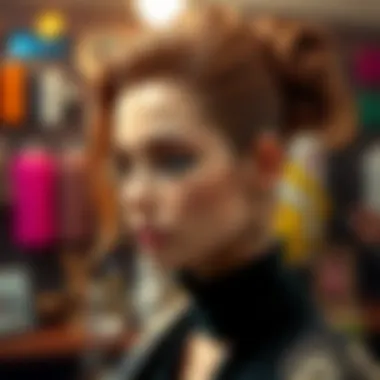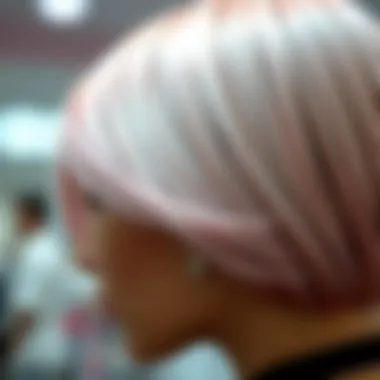Essential Hair Cut Accessories Every Stylist Needs


Intro
In the dynamic world of hair styling, the right accessories can significantly impact the outcome of a grooming session. From the swish of scissors to the hum of clippers, every tool has its purpose, and their roles intertwine to enhance the stylist's craft. This exploration dives into the realm of hair cut accessories, revealing their functional importance and how the right gear can elevate a stylist's skills. As we progress through this guide, we will uncover the significance of each accessory while providing insights that are worthwhile for both aspiring and seasoned stylists alike.
Hair Cutting Essentials
The Must-Have Tools for Every Stylist
When one thinks of hair cutting, scissors usually come to mind first. These aren't just any scissors, though. Professional hair cutting scissors differ in design and sharpness compared to ordinary household scissors. They allow for precision cuts and can make a world of difference in the final look. Quality scissors, such as those from brands like Wahl or Fiskars, can turn a mundane cut into a masterpiece with the right technique.
Not far behind are clippers. These machines have carved their place in barbershops and salons globally. They allow for quick, uniform cuts, and their variety extends from battery-operated handheld options to robust models that can tackle even the thickest locks. Investing in a reliable clipper, like the Andis Master or Oster, can be game-changing for stylists working on short styles or fades.
Combs and Brushes
Of course, one mustn't forget about combs and brushes—vital companions in any stylist's arsenal. Different types of combs serve varying purposes; for instance, wide-tooth combs are ideal for detangling, whereas fine-tooth combs can help in achieving intricate styles. Similarly, brushes, ranging from paddle brushes for smoothing to round brushes for creating volume, can dramatically alter the hair's texture and feel.
When using these tools, one must take into account the type of hair one is dealing with. For thicker hair, a denser brush can work wonders, while finer hair might benefit from a more gentle touch. A stylist's ability to choose the right brush or comb can elevate their skill set significantly.
Effective hairstyling is not just about the hands; it's about the tools used, enhancing artistry with technology.
Protective Gear
As any savvy stylist knows, proper hygiene and safety are paramount. Protective gear like capes and aprons not only keep the client clean but also provide a professional appearance. Capes should be tailored to fit different body types while ensuring comfort and practicality. Likewise, gloves can be essential when using certain coloring products, delivering a degree of safety for both the stylist and the client.
Incorporating these protective items into one’s routine can foster a professional environment that prioritizes cleanliness and comfort.
Ending
Mastering the craft of hairstyling is as much about the technique as it is about the various accessories used. Each tool has its own purpose and significance. Understanding how and when to utilize them can elevate a stylist's work game, reaching new heights in creativity and execution. By gathering the right assortment of hair cut accessories, any stylist can enhance their skills and push their artistry to the forefront of the styling industry.
As we delve further into the realm of hair grooming tools, we gain insights into how each accessory contributes to techniques that can shape, mold, and define personal style.
Foreword to Hair Cut Accessories
Understanding hair cut accessories is not just about knowing what tools to grab before starting a new hairstyle; it’s about appreciating the impact each accessory has on the outcome of hair cutting and styling. For stylists, these tools are like the brushes to a painter or the pen to a writer. They define the quality and efficiency of the work being produced. Whether you're a seasoned professional or a beginner in the hair grooming industry, knowing the ins and outs of these accessories can significantly influence your abilities and results.
Defining Hair Cut Accessories
Hair cut accessories refer to the various tools used by hairstylists to create, shape, and enhance hairstyles effectively. These range from the obvious, like scissors and clippers, to the lesser-known, yet equally vital accessories such as combs, capes, and even headbands. Each category serves a specific purpose in the hair styling process, addressing different needs—be it cutting, shaping, or merely controlling the hair during a service.
In numeric terms, it’s like counting the ingredients in a recipe: scissors for cutting, clippers for trimming, combs for detangling, and brushes for styling. Not to mention the protective gear that ensures clients remain comfortable and their clothes stay spotless. All together, these tools create a seamless experience.
Importance in Hair Styling
The significance of hair cut accessories goes beyond their functional roles. They have a profound effect on the styling process and the overall client experience. Having the right tools can streamline the haircutting procedure, making it faster and more efficient. Here’s a snapshot of their importance:
- Precision: Certain accessories help in achieving precision that can make or break a hairstyle. A fine-toothed comb or sharp scissors gives a stylist the control needed for intricate cuts.
- Versatility: Different tools enable stylists to cater to a variety of hair types and styling demands. A stylist's toolbox may include tools for everything from delicate baby hair trimming to robust clipper cuts.
- Client Comfort: Accessories like capes and headbands not only protect the clients but also enhance their experience by adding an element of comfort and style.
As a stylist, considering the right accessories is akin to choosing the right instruments for a concert. The harmony and quality of the final product depend significantly on the accessories utilized.
"It's the tools that often set the floor apart from the audience, bringing each stylist's artistic vision to life."
In sum, hair cut accessories are essential. They elevate the hairstylist's work and ensure that creativity translates into tangible results. Without these tools, the art of hair cutting would lack its full potential, leaving everyone involved a bit less satisfied.


Types of Hair Cut Accessories
Understanding the different types of hair cut accessories is paramount for any stylist, whether they are just starting out or have years of experience. These accessories are not just tools; they contribute significantly to the craftsmanship of hair styling, helping to produce polished results. Choosing the right accessories aids in achieving precision cuts, adding flair to hairstyles, and ensuring a professional environment. With various tools available, each serves specific functions that cater to different techniques and styling needs.
Scissors and Shears
Scissors and shears are the foundation of any hairstyling toolkit. Not just ordinary cutting devices, they play a crucial role in determining the haircut’s outcome.
Different Types of Scissors
Different types of scissors are designed for specific functionalities, from cutting to texturizing. For instance, straight-cut scissors are excellent for achieving clean lines, making them popular for blunt cuts. Conversely, thinning shears have notched blades, allowing stylists to blend and reduce bulk without sacrificing length. Their unique feature—varying blade designs—enhances their versatility, making them a beneficial choice for dynamic haircuts. However, having too many styles can complicate a stylist's toolkit instead of streamlining it.
Scissor Materials and Their Impact on Performance
The material used in scissors greatly affects their performance. Stainless steel is a common choice, valued for its durability and resistance to rust. On the other hand, high-carbon steel is known for its sharpness and ability to hold an edge but might require more care to prevent corrosion. Stylists must consider their projects' demands and their commitment to maintenance. Each material has its advantages and drawbacks; for instance, high-carbon steel provides a cleaner cut but may need more frequent sharpening.
Maintenance Tips for Scissors
Proper maintenance of scissors is vital to ensure they function effectively over time. Regular cleaning, oiling hinges, and keeping them in protective cases can extend their life significantly. One practical tip is to always cut on the right surface; using a cutting mat instead of hard surfaces can avoid nicks and dulling. While maintenance might seem tedious, neglecting these practices could lead to subpar performance and increased replacement costs.
Hair Clippers
Hair clippers are indispensable for stylists who work with shorter hairstyles. They facilitate quick and even haircuts and can be used for various styles, from buzz cuts to fades. Their importance cannot be overstated; they bring efficiency and a level of precision that's hard to achieve with scissors alone.
Exploring Various Clipper Styles
Variety in clipper styles offers options tailored to different techniques. Corded clippers provide consistent power, making them ideal for professional settings, whereas cordless models offer flexibility and ease of maneuverability. Their unique designs cater to different preferences and types of work, with cordless options being favoured for travel and ease of use. However, battery life can be a concern for heavier users.
Blade Variations and Their Functions
The blades on hair clippers vary significantly, with various teeth configurations affecting cutting techniques. Fixed blades are commonly utilized for even length, while adjustable blades allow for diverse cutting lengths, catering to different hair textures and styles. This feature enhances versatility but requires a slight learning curve, especially for new stylists.
Proper Care and Usage of Clippers
To keep clippers in peak condition, regular cleaning and oiling are essential. After each use, especially in a busy salon, removing hair from the blades prevents clogging, ensuring a smooth cut during future sessions. Additionally, using the right comb attachment is crucial, as it dictates the length of the cut. Neglecting these aspects could lead to poor cutting performance or unnecessary expenditure on repairs.
Combs and Brushes
Combs and brushes might seem simpler than clippers or scissors, but they are just as instrumental in achieving desired styles. The right tools can make a significant difference in both the application of techniques and the final appearance of a hairstyle.
Types of Combs: Fine, Wide, and Tail Combs
Different types of combs serve distinct purposes—fine-toothed combs help in detailing while wide-toothed combs are essential for detangling, particularly in textured hair. The tail comb, with its pointed end, provides precision in sectioning hair. This diversity in combs allows stylists to address various hair types and styling methods effectively, making them an essential part of every stylist’s kit.
The Role of Brushes in Styling
Brushes, on the other hand, are vital for enhancing the finished look of any hairstyle. Round brushes are particularly useful for creating volume and waves, while flat brushes help achieve smooth, shiny finishes. Their impact on styling is significant; the right brush can increase efficiency and improve results. However, using the wrong brush can lead to frizz or damage, so knowing the best options for different hair types is crucial for success.
Material Choices: Plastic vs. Natural Fibers
When choosing between brushes made of plastic or natural fibers, each material has unique advantages. Plastic brushes tend to be more affordable and easier to clean. In contrast, natural fiber brushes can offer a smoother finish and are often gentler on hair. They can provide a more polished look, but the cost is typically higher. Weighing the benefits and drawbacks is essential for selecting accessories that fit both budget and usage needs.
Hair Accessories


Hair accessories play a pivotal role in both functionality and aesthetics. They can greatly enhance hairstyling, adding a personal touch or helping to manage strands effectively.
Bobby Pins and Clips
Bobby pins and clips are essential for securing hair in place during cuts or styles. Their versatility is noteworthy; bobby pins can hold various styles while clips are great for sectioning hair. While they appear small and simple, both offer enormous utility, making them must-haves in any stylist's collection. However, using the wrong size or type can lead to slippage or discomfort for clients.
Headbands and Hair Ties
Headbands and hair ties come in every style imaginable, from the functional to the fashion-forward. They serve not only a practical purpose—keeping hair out of the face during cutting or styling—but also act as a style statement. However, while they are generally affordable, quality matters; cheap hair ties can break or damage hair.
Importance of Aesthetic Accessories in Styling
The aesthetic component of styling shouldn't be overlooked. Accessories not only elevate a haircut but also allow stylists to express creativity. However, there's a fine line between trendy and excessive; using too many accessories can detract from the hairstyle's appearance, so balance is key.
Protective Gear
Protective gear is integral to ensuring a safe and hygienic environment in salons. It's not just about looking professional; it's about protecting both the stylist and the client.
Capes and Gowns
Capes and gowns are the frontline defense against hair and chemicals during a cut. They ensure that clients remain comfortable and clean, thus enhancing their experience. A well-fitted cape can also impart a sense of professionalism to the stylist. However, the effectiveness of this gear also hinges on material quality; flimsy capes can lead to discomfort or dissatisfaction.
Face Shields and Masks
Face shields and masks have gained prominence for hygiene reasons. They protect against hair, sprays, and potential contaminants. With the rise of health consciousness, having high-quality shields is necessary. One downside is that they can sometimes feel cumbersome, impacting the stylist's comfort level.
The Role of Protective Gear in Professional Settings
In professional settings, the use of protective gear goes beyond safety; it defines the salon’s image. Clients appreciate a hygienic environment, which fosters trust and encourages return visits. Furthermore, understanding the need for and correct usage of protective gear can significantly impact the overall client experience and reduce liability for salon owners.
Protective gear isn't just a safety measure; it's a commitment to professionalism and quality service.
Selecting the Right Accessories
Choosing the right tools in hair cutting is not just a trivial task for stylists, it’s crucial for a successful haircut. The right accessories can make all the difference in achieving the desired look while ensuring client satisfaction. Selecting these tools involves careful consideration of several elements which can significantly impact the final outcome.
Factors to Consider
Hair Type and Texture
Understanding hair type and texture is fundamental when selecting cutting tools. Hair texture can range from fine and silky to thick and coarse. For instance, fine hair may require lighter cutting tools that provide precision without causing damage. In contrast, thicker hair often benefits from sturdier scissors or clippers that can manage its weight more effectively.
The key characteristic of hair type lies in its density and porosity. Density can dictate how much hair can be cut at once, while porosity affects how well it absorbs moisture and product. By evaluating these traits, stylists can make informed decisions about tools that align with their client's needs. An example of a beneficial choice is using thinning shears on thick hair to remove bulk without compromising the overall shape.
However, stylists should also keep in mind the unique challenges that various textures present. Fine hair may require tools with a fine blade to avoid leaving too much room for manipulation, whereas coarser textures might necessitate tools that can seamlessly glide through without pulling. Ultimately, this consideration ensures better results for the stylist and the client alike.
Styling Goals and Techniques
Understanding the styling goals and techniques plays a significant role in selecting the right accessories. Haircut styles range from blunt cuts to layered looks, each requiring different tools. For example, when opting for a layered cut, a stylist might choose long scissors for a seamless effect while using texturizing shears to create movement.
The unique feature of styling goals is that they define the finish and feel of the haircut. For instance, if a stylist is aiming for a textured bob, they are likely to reach for razors or slicing scissors rather than traditional blunt-cutting tools. Therefore, knowing the desired outcome can help in selecting tools that are not just effective but also efficient.
It is essential that stylists also factor in their own techniques, as different professionals may have tailored methods that resonate with their cutting style. Some might prefer precision over speed while others might work faster but with wider strokes. This consideration allows for a tailored toolkit that suits their unique approach to hair cutting, ensuring that both stylist and client are happy with the results.


Budget Considerations
Budget considerations are another important facet of selecting hair cutting accessories. Quality tools can be a significant investment, and understanding the balance between price and performance is crucial. It’s tempting to opt for budget tools, but often these instruments can result in lackluster cuts or won’t hold up over time.
The key characteristic of budget tools is the necessity of evaluating their durability and effectiveness versus cost. A pair of scissors priced lower might seem appealing but can lead to frustration if they dull quickly or don’t perform well on specific hair types. Conversely, investing in high-quality tools can pay off in long-term performance and client satisfaction.
Stylists should also consider whether they need to build their collection over time. Starting with essential pieces – like a quality pair of scissors and clippers – and adding more specialized tools later can stretch budget while ensuring they still have what they need on hand for various styles. Careful planning and purchasing of accessories not only ensures professional growth but also satisfaction from clients over time.
Brands and Quality Indicators
The influence of brands and quality indicators cannot be overstated in the realm of hair cutting accessories. Recognizable brands often symbolize reliability and offer products tested through extensive use in real-world settings. Seeking out well-reviewed brands can guide novice stylists to selections that have proven effective over time.
When evaluating quality, factors such as material, ergonomics, and user feedback come into play. Scissors made from high-carbon steel are generally preferred over those made from stainless steel due to their sharpness retention and durability. For clippers, a reputable brand ensures that they stay cool during use, have adjustable blades, and deliver precision cutting.
To sum up, being strategic about purchasing hair cutting accessories not only elevates the work of a stylist but also enhances their reputation in a competitive industry. It fosters confidence in choosing tools that align well with the diverse requirements of clients. Utilizing a blend of personal style, hair type considerations, and knowledgeable spending will ultimately create a fruitful toolkit.
Trends in Hair Cutting Accessories
The world of hair styling is always shifting and evolving, and it’s not just about the styles themselves. The tools and accessories that accompany these hairstyles are equally important. As trends change, so too do the accessories that hair stylists and enthusiasts utilize. Understanding these trends isn't just for style; it’s about improving technique, ensuring efficiency and creating a better experience for both the stylist and their clients.
Innovative Tools for Stylists
Hair stylists are increasingly seeking tools that are not just functional but also push the boundaries of creativity. Recent innovations have brought forth tools that integrate technology with traditional methods, making every snip a sophisticated experience. For instance, smart hair clippers now come equipped with adjustable blade speeds and even Bluetooth connectivity to help track hair clip styles and preferences.
Some popular innovative tools include:
- Laser-guided scissors that assist in precision cutting, ensuring a clean line without the need for repeated snips.
- Cordless clippers that provide freedom of movement, making it easier to reach difficult angles without the hassle of cords getting in the way.
- Multi-functional styling tools, like all-in-one clipper and trimmer combos, eliminate the need for multiple devices, saving both space and time.
Such advances can not only elevate the quality of a haircut but also enhance the stylist's efficiency. Being ahead of technology trends can differentiate a stylist from others, drawing in clients who appreciate cutting-edge service.
Sustainable and Eco-Friendly Options
In an era where environmental awareness is at the forefront, many hair stylists are also leaning towards sustainable accessories. Eco-friendly products are more than just a trend; they represent a shift in values and practices in the industry. Business owners recognize the importance of appealing to a clientele that prioritizes sustainability. For instance, bamboo combs and brushes have gained popularity because they are biodegradable and often produced without harmful materials.
Some key points to consider about eco-friendly options include:
- Recyclable materials: Many brands are opting for materials that can be easily recycled rather than those that contribute to waste.
- Locally sourced products: Supporting local suppliers not only minimizes carbon footprints but helps strengthen communities.
- Durability and longevity: Sustainable accessories are often designed to last longer than cheaper counterparts, reducing waste in the long run.
By incorporating these options, stylists not only contribute to environmental health but also attract a growing demographic that values sustainable practices. As the industry adopts responsible practices, selecting tools that are kind to the planet can create a positive impression and foster loyalty among eco-conscious clients.
"Choosing sustainable tools means you’re not just cutting hair; you’re cutting down on waste."
Finale
Hair cutting accessories are undeniably the backbone of any stylist's toolkit. As explored throughout this article, each accessory—from scissors to clippers, combs to protective gear—serves a unique purpose that can significantly influence both the process and results of a haircut. Understanding the importance of these tools goes beyond just using them; it’s about mastering their capabilities to enhance artistry in hair styling.
Summarizing the Significance of Hair Cut Accessories
The vital role of hair cut accessories cannot be overstated. They are not merely an afterthought; they are essential ingredients in the recipe of hair artistry. The right scissors can be the difference between a clean cut and a jagged one, while high-quality clippers can create smooth transitions between styles. Each accessory holds its own significance:
- Precision: Tools like shears allow for intricate detailing and personalizing styles that reflect the client’s wishes.
- Efficiency: Clippers designed for specific hair types can save time, making the haircut experience enjoyable for both the stylist and the client.
- Safety: Using proper protective gear helps ensure that both the stylist and clients are safeguarded against accidents, allowing for a stress-free environment.
Therefore, it’s clear that possessing a variety of quality accessories directly correlates to a stylist’s success. Recognizing their value helps stylists create their distinct signature styles while meeting the diverse demands of their clientele.
Final Thoughts on Choosing the Right Tools
When it comes to selecting hair cut accessories, several considerations emerge. First off, being aware of one’s own style and the needs of clients is crucial. Different hair types, textures, and styling goals call for tailored tools. For instance, a stylist focusing on precision cuts may prefer shears designed for fine hair, while those working with textures will need robust, durable clippers.
Budget also plays a key role. Investing in fewer, high-quality tools will often yield better results in the long run compared to filling a drawer with inferior products. Look for brands recognized for quality and durability. A solid reputation often points to a tool's reliability, which can be invaluable in a busy salon setting.
In summary, the landscape of hair cutting accessories is vast and full of potential. Each piece not only contributes to the act of cutting hair but also enriches the creative expression of stylists everywhere. As the hair styling industry continues to evolve, so too will the accessories that define it. Therefore, it is crucial for stylists to stay informed and selective about the tools they choose, ultimately enhancing their craft and improving the experience for their clients.



